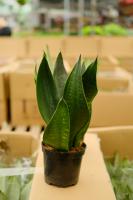How to Support Tomato Plants in a Grow Bag
Tomatoes are one of the most popular backyard crops, and for good reason - they're delicious, versatile, and easy to grow. One way to cultivate them is in a grow bag, which offers several advantages, including portability, ease of use, and affordability. However, if you want to get the most out of your tomato crop, you need to support the plants properly. In this article, we'll discuss the basics of how to support tomato plants in a grow bag.
Choosing the Right Grow Bag
The first step in supporting your tomato plants is to choose the right grow bag. There are a variety of brands and materials available, but the most important factor is size. Tomatoes have deep root systems, so you want a bag that is at least 18 inches deep - the deeper, the better. You should also consider the width of the bag, as the plants will need room to spread out. A good rule of thumb is to use a bag that is roughly twice the size of your plant at maturity.
Selecting the Proper Support System
Once you have your grow bag selected, it's time to choose a support system. The two most common options are stakes and cages. Stakes are simply long, thin poles that you insert into the soil and tie the plant to as it grows. They are cheap and easy to install, but may not be sturdy enough for larger plants or heavy fruit loads. Cages, on the other hand, are wire structures that surround the plant and provide support from all sides. They are more expensive, but offer better stability and are less likely to damage the plant than stakes.
Planting the Tomatoes
Before you can begin supporting your tomato plants, you need to plant them. Start by filling your grow bag about halfway with soil mix that is rich in organic matter. Create a small depression in the center of the soil and remove the plant from its pot. Place the plant in the depression and gently pack the soil around the base, making sure it is level. Water the plant well and let it settle in before adding your support system.
Installing the Support System
Once your tomato plants are in the grow bag and have had time to acclimate, it's time to install your support system. If using stakes, insert them into the soil about 2 to 3 inches away from the plant, being careful not to damage the roots. Tie the plant to the stake with garden twine, starting about 6 inches from the base and continuing at 6-inch intervals up the stem. Be sure to tie the twine loosely enough to allow for growth, but tight enough to prevent the plant from falling over.
If using a cage, simply place it over the plant and push the legs into the soil to anchor it. The cage should be at least 3 feet tall and 2 feet in diameter to allow for proper growth. The plant will naturally grow into the cage and you may need to do some light pruning to keep it from becoming too dense.
Maintenance
After your tomato plants are supported and established, it's important to keep them healthy and well-maintained. Water the plants deeply once a week, making sure the soil is uniformly moist but not waterlogged. Fertilize every 2 to 3 weeks with a balanced, slow-release fertilizer. Keep an eye out for pests and diseases and treat promptly if necessary. Finally, be sure to prune the plants as needed to maintain good air circulation and prevent overcrowding.
In Conclusion
Tomatoes are a rewarding crop to grow in a grow bag, and proper support is key to maximizing your harvest. By selecting the right grow bag, choosing an appropriate support system, planting correctly, and providing proper maintenance, you can enjoy a bountiful crop of fresh, delicious tomatoes throughout the growing season.

 how many times do yo...
how many times do yo... how many planted tre...
how many planted tre... how many pine trees ...
how many pine trees ... how many pecan trees...
how many pecan trees... how many plants comp...
how many plants comp... how many plants can ...
how many plants can ... how many plants and ...
how many plants and ... how many pepper plan...
how many pepper plan...

































